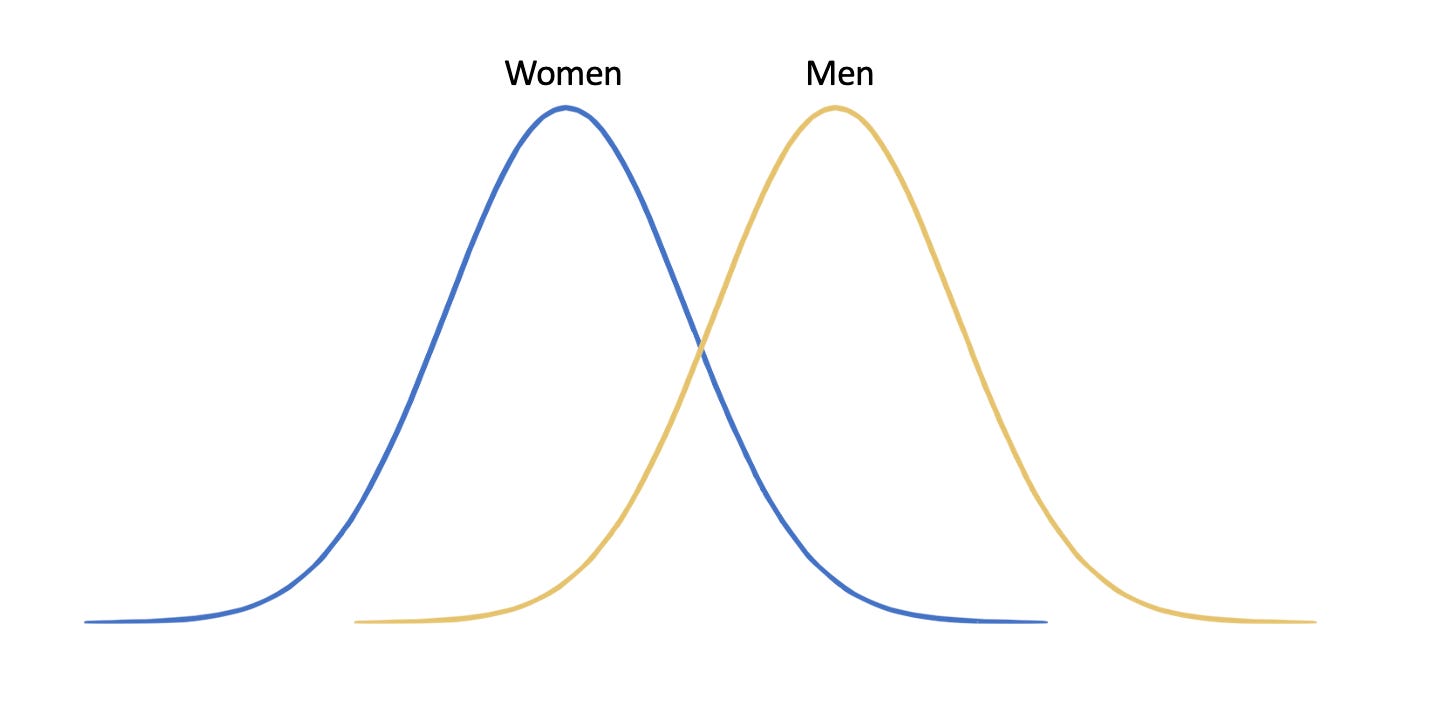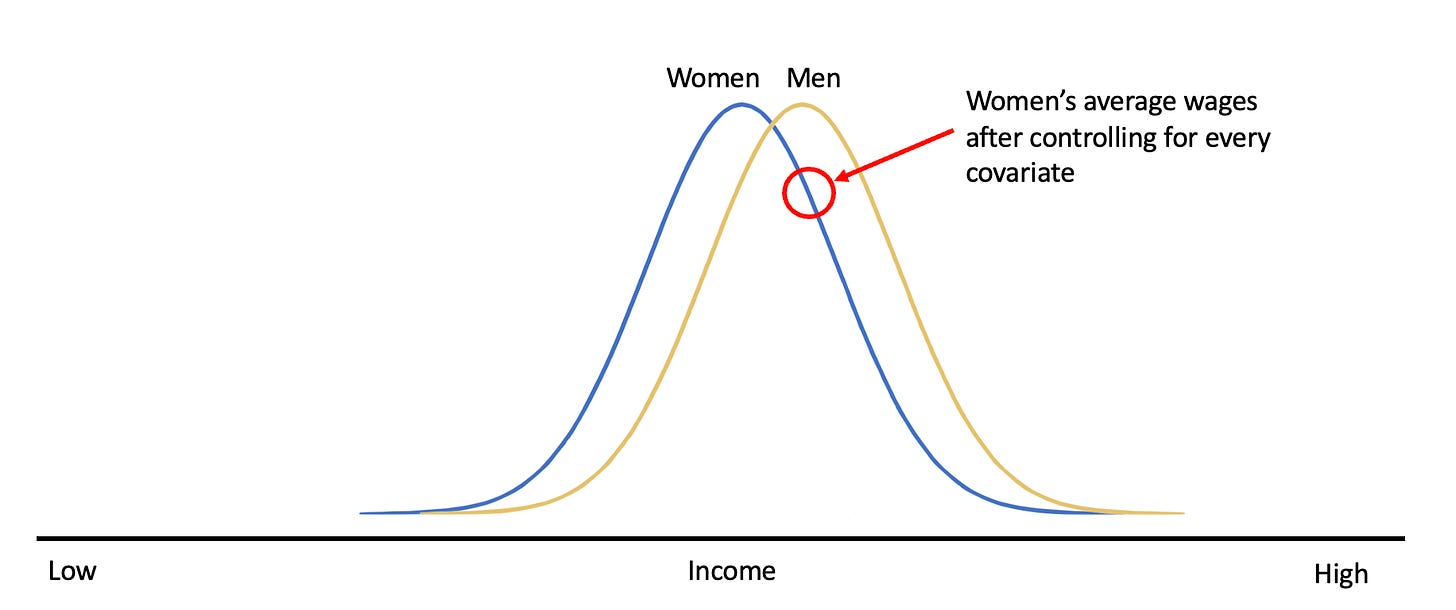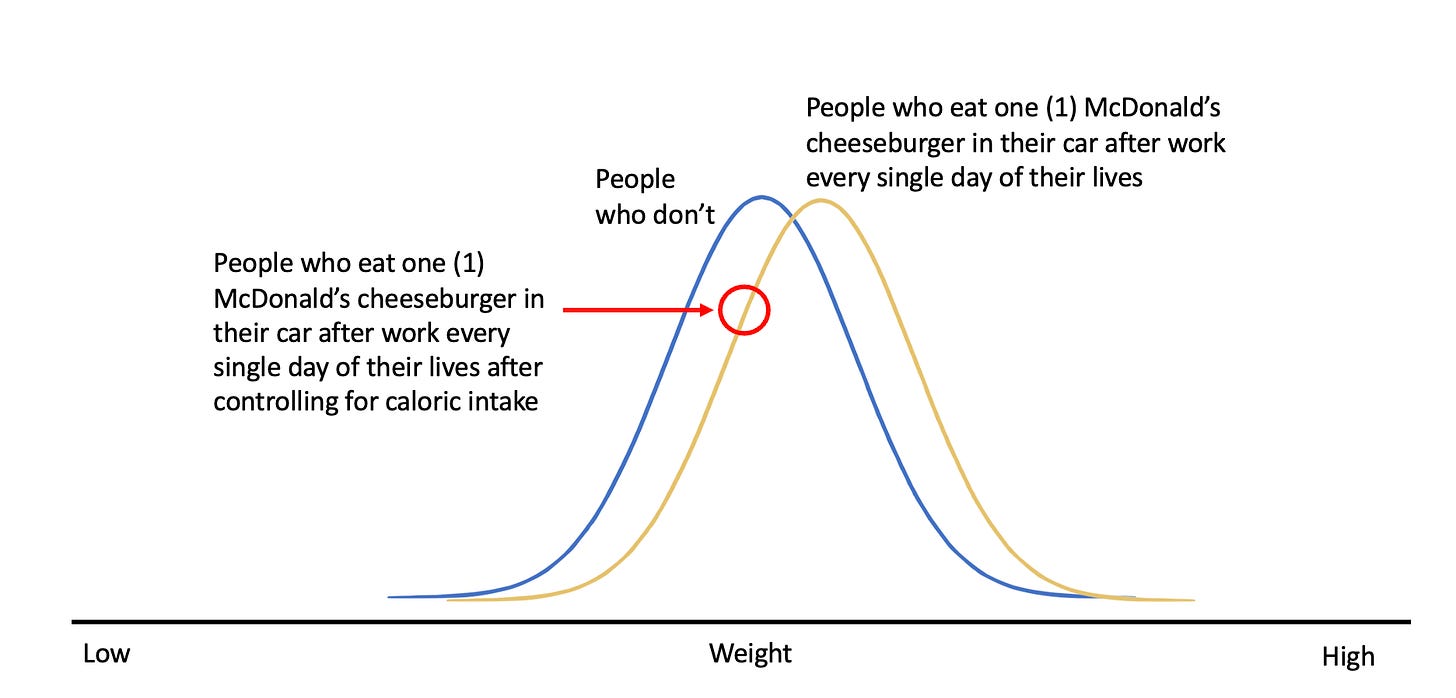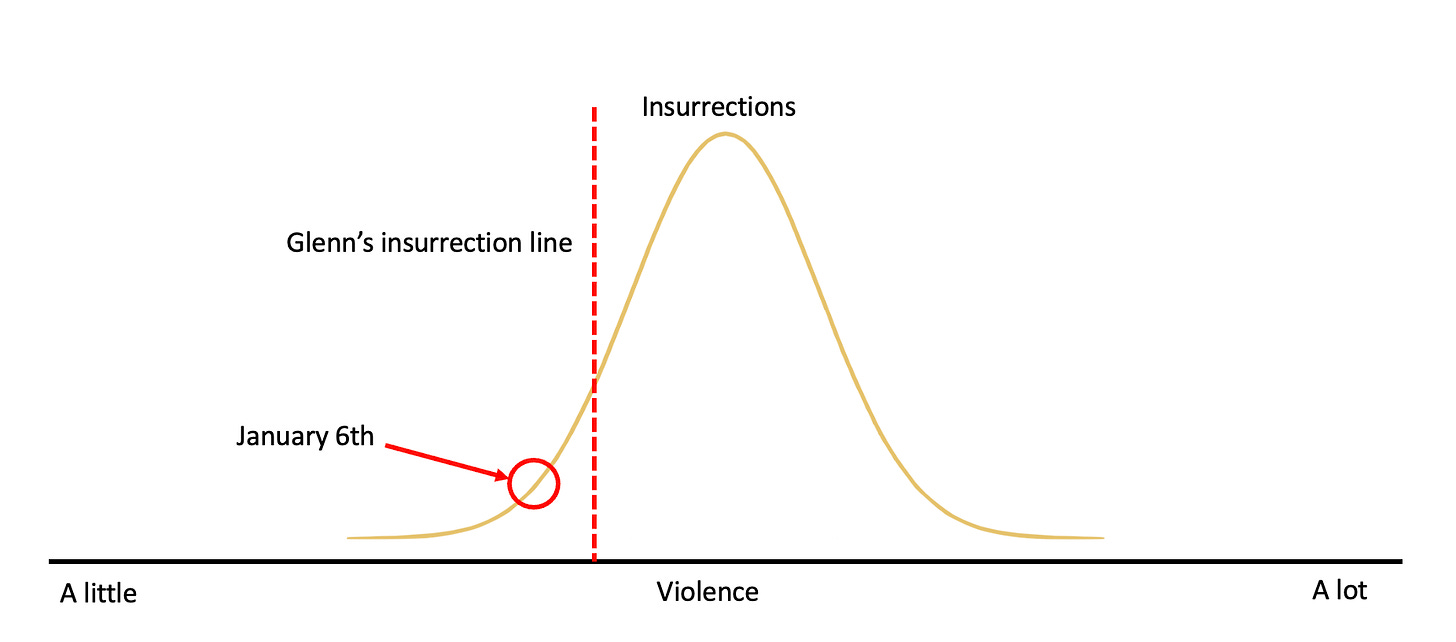Graphing Arguments
Or: how can we shoehorn normal distributions into January 6th insurrection discourse?
Men, on average, are taller than women. This is uncontroversial. If we were to graph the distributions of height in men and women we’d get something that looks like this:
Importantly, the claim that men are, on average, taller than women doesn’t mean there aren’t outliers. Some men are very short and some women are very tall, so much so that they look like typical members of the other sex. Nevertheless, the average difference remains.
Plotting distributions like this might seem trivial when talking about something as mundane as sex-based height differences, but their value becomes clear when conversations are more heated. In this post, we want to review some ways in which a distribution-based analysis reveals, illustrates, and (in some cases) resolves many arguments.
Exaggerations of existing disparities:
If you were online in 2016, you should remember the Brock Turner case: a Stanford athlete brutally assaulted a drunk woman behind a dumpster, and was given what amounted to a slap on the wrist for an extremely serious crime — he only served three months.
An important bit of context is that this happened only a year or so after the shooting of Michael Brown in Ferguson, so police racism was highly salient in a similar way to America in the year or so post-George Floyd. Brock Turner’s favourable treatment was inevitably compared to Michael Brown and other Black victims of police violence, even in mainstream media. Here’s an image from the CBC:
If we were to plot the media narrative at the time for how Black or White people are treated by the criminal justice system, it would look something like this:
On this account, Brock Turner was given leniency because he was white, and the Black woman who was simply letting her children play in the park was punished because she was Black. While it’s generally true that Black people are disproportionately punished in the legal system, this imagined distribution is an extreme exaggeration.
For example, meta-analyses of racism in sentencing suggest a real, but small bias. A meta-analysis of federal conviction data in the Journal of Quantitative Criminology suggests racial effects of sentencing severity of somewhere between 10-20%. Another meta-analysis in the journal Aggression and Violent Behaviour suggests that even these effects are overstated or even null, though they do find evidence of a small racial bias with respect to drug crimes. A more honest distribution might look like below:
To be clear, Brock Turner was given an absurdly lenient sentence, but we know it was absurdly lenient in part because the judge who gave it was quickly removed from his position by voters in 2018 (per the BBC, the last Californian judge given the same treatment was removed in 1932).
The woman who let her kids play in the park was also given an absurdly harsh punishment. But the average differences between groups are nevertheless much smaller than those individual cases would suggest. Media narratives that focus on comparing outlier cases are dishonest insofar as they exaggerate real problems that are bad enough without unrepresentative comparisons.
Category disputes disguised as factual disagreements
As with Brock Turner, unless you were in a meditation retreat for the entirety of the past couple years, you’ve probably heard of Lia Thomas, the transgender swimmer who smashed NCAA records for her freestyle races last year.
The question on everyone’s minds was: “is this fair?”
(There’s a separate argument about the ontological status of trans women that we won’t touch here, but “is she a woman?” would also be relevant for determining whether she should compete in women’s sports. Frankly, we believe she is a woman, and litigating that here would ultimately detract from our broader point. Even if she’s a woman, it could still be fair or unfair for her to compete)
If we were to plot men and women’s swimming performance, it would look something like this:
Here’s our best representation of the two sides of the argument:
This is fair: Lia Thomas has fulfilled her obligation to be on gender-appropriate hormones, and this has likely resulted in significant muscle atrophy, reducing her speed and bringing her closer into the female performance range. Many athletes, such as Michael Phelps, have abnormalities like webbed feet that make them better than others could hope to be, and Lia Thomas ought to be treated similarly.
This is unfair: Lia Thomas had the advantage of living and training as a man for decades prior to transition. As such, she has stronger muscles, faster reflexes, and better overall athletic capabilities of woman who have put in similar levels of effort. Lia Thomas competing against women is like letting someone who’s been on performance enhancing drugs their entire life stop taking them for a couple years and then crush everybody else.
What’s important here is that both sides would probably say they have a factual disagreement, but if you plotted out their model of Lia Thomas’ performance, it would look identical:
The relevant question is not: “did Lia Thomas swim faster pre-transition”, or “how fast is Lia Thomas now”, but rather: “which distribution should Lia Thomas be placed on?” If you place Thomas in the men’s distribution, then she is a mediocre man beating women. If you place her in the women’s distribution, then she is a high performing woman.
Setting aside ontological concerns about transgender people, how would you resolve this argument? One way might be to look to research on the extent to which transition erodes performance advantages of males post-transition to women. If it is the case that transition does not fully reduce a male performance advantage, then perhaps the analogy to performance enhancing drugs is more apt, which may bear on the fairness question.
Notably, virtually no one online seems to want to talk about research of this sort. Arguments are instead stuck at level-one takes wherein someone on the anti-trans side will say “she was mediocre before and at the top of her game now!” and someone on the anti-trans side will say “but she’s swimming slower now than she did before!”, which aren’t really points that cut to the heart of the matter.
Controlling for Mediators
Men make more money than women. There’s different estimates for the extent of this gap, but people seem to put it in the 10 to 20c advantage. For every dollar a man makes, a woman makes 80-90 cents. To plot this distribution again, we get something like this:
But then there’s familiar objections to wage gap discourse:
Women work less hours than men
Women choose lower paying jobs than men
Women don’t negotiate for higher salaries than men
Women work part-time
The wage gap is all a motherhood penalty
These are all true points worth mentioning. The naive perspective offered by many pundits that women don’t make the same money for the same work is simply false. It is also true, however, that controlling for these covariates can ultimately be controlling for a mechanism of the process by which women are paid less than men. In other words, suppose sexism were to factor in to why women choose certain jobs. Controlling for job choice when estimating income would then not be an adequate rebuttal to the sexism charge, because the variance in income attributable to sexism would be partially captured by job choice.
To illustrate why this is flawed consider another distribution, this time comparing the weight of people who eat one McDonald’s cheeseburger a day versus those who don’t, but also controlling for caloric intake.
Controlling for caloric intake makes no sense because eating McDonald’s cheeseburgers directly increases one’s caloric intake! As with McDonald’s, so too with wage gaps.
Clarifying Definitions
One of our favourite debates of the last year was Destiny vs. Glenn Greenwald on the topic of the January 6th insurrection, which you can watch here:
A key component of the disagreement between Destiny and Glenn was the degree to which severity matters for something to be called an insurrection. Specifically: does a riot being small or less violent than a typical insurrection make it not an insurrection?
Destiny’s definition of an insurrection (itself taken from the recent Colorado Supreme Court ruling) was as follows: “an insurrection … is 1) a public use of force or threat of force, 2) by a group of people, 3) in order to hinder or prevent the execution of the condition of the United States”.
It was not disputed that the January 6th riots constitutes a group of people or that they tried to prevent the peaceful transfer of power, however incompetently, which therefore satisfies conditions #2 and #3. What Destiny and Glenn got stuck on was the degree to which violence was required. Destiny’s definition, taken seriously, allows for insurrections to range from extremely violent to just somewhat violent. A totally non-violent insurrection wouldn’t qualify, but one with a small amount of violence would:
Destiny and Glenn both generally agreed on the level of violence at the Capitol. A crowd of tens of thousands of rioters broke down gates, some entered the Capitol building by force, smashing windows to get in. The crowd was yelling slogans like “hang Mike Pence!” and searching for legislators they hated. However, there were no murders — the only people to die were Ashli Babbitt (who violently broke into an area where legislators were hiding), and a few old people who had heart attacks or drug overdoses totally unrelated to the riot.
The question was the extent to which non-violence at the capital was relevant or what level of violence is required to constitute an insurrection. Glenn argued that the Capitol riot wasn’t violent enough to constitute an insurrection. In picture form:
Notably, incidents of non-violence do not count against the incidents of violence. You can’t not shoot somebody 1,000 times, shoot them once and then claim “I was 99.9% peaceful!”. And Glenn’s dividing line doesn’t make sense given the Colorado Supreme Court’s definition, which only specifies that violence is used, not that violence must exceed a particular threshold.
Conclusion
Graphing arguments in this way doesn’t totally resolve disputes, but explicitly drawing them out like this is a useful way to clearly and accurately represent different perspectives and models of the world. These graphs also avoid misinterpretations such as people assuming “men are taller than women” as a claim that all men are taller than all women.
Thanks for reading! If you enjoyed this post please give it a like and share, and maybe subscribe? If you hated it, feel free to argue in the comment section!













Yes! Graphing disagreements can be a very useful tool. I found myself very frustrated by the Glenn/Destiny debate partly because I find debates over definitions to be tedious, but also because it was obvious how much of the disagreement was purely on where you would draw the 'insurrection' line on the violence scale. Destiny got Glenn to admit that the battle of Fort Sumter should not count as an insurrection (!!) but he really should've done more to probe Glenn's threshold.
I must say, I find the argument about trans athletes a bit weaselly.
Female sporting events exist because we recognise that female people (regardless of their gender identity) are systematically weaker, slower and less resilient than male people (regardless of their gender identity), but still want female people to experience the pleasure of taking part in sporting events in which success is a possibility. I don't think it's difficult to understand why many female athletes feel cheated or betrayed when a sporting event is created with the explicit purpose of being for female people only, the body governing that event then starts allowing certain male people to compete, and when challenged the body's rebuttal is "oh no, [male athlete] has actually handicapped themselves so much that they're within the normal distribution for female athletes, so no harm done". Even if this is true (and it's a big "if"), it's kind of an irrelevant objection. The sporting event was founded with the explicit purpose of "for female people only", not "for female people and sufficiently handicapped male people" or "for people who identify as women" or "for any sufficiently weak person, regardless of sex".
To continue the analogy to performance-enhancing drugs: in order to accuse an athlete of cheating by using prohibited drugs known to improve performance in sporting events, all you are required to do is provide evidence that they used those drugs. I'm not aware of any requirement that you demonstrate that their performance actually improved as a result of taking those drugs. If Bob loses a swimming race to Joe, and Bob subsequently discovers ironclad evidence that Joe was using PEDs at the time of the race, Bob is well within his rights to point out that Joe broke the rules and should be disqualified. If Joe defended himself by saying that his performance under the PEDs was within the margin of error for his performance without - this is a completely irrelevant defense *even if it's true*. The rule is "don't use these drugs", not "don't use these drugs (unless you can demonstrate that they didn't help you win, in which case knock yourself out)".